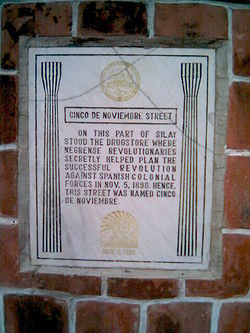Negros Revolution
| Negros Revolution of 1898 | |||||||
|---|---|---|---|---|---|---|---|
| Part of the Philippine Revolution | |||||||
 Cinco de Noviembre Memorial Marker in Silay City, Negros Occidental, Philippines |
|||||||
|
|||||||
| Belligerents | |||||||
|
|||||||
| Commanders and leaders | |||||||
|
|
|
||||||
| Casualties and losses | |||||||
| unknown | unknown | ||||||
Decisive Filipino victory
The Negros Revolution, now commemorated and popularly known as Al Cinco de Noviembre or Negros Day, was a political movement that in 1898 created a government in Negros Island in the Philippines, informally ending Spanish control of the island and resulting in a government run by the Negrense natives, at least for that part of the archipelago and for a relatively short period. The newly established Negros Republic lasted for approximately three months. American forces landed on the island unopposed on February 2, 1899, ending the island's independence.
It has been stipulated that the Spanish civil and religious authorities in Negros did not initially suspect that the sugar barons and traders of the island would participate in an uprising against Spain. The clergy in Negros had not acquired vast tracts of land, unlike their contemporaries on the island of Luzon. Negros had become a rich province and the local leaders were said to be "content, sharing even in many instances the social privileges of the Spanish elite."
...
Wikipedia
